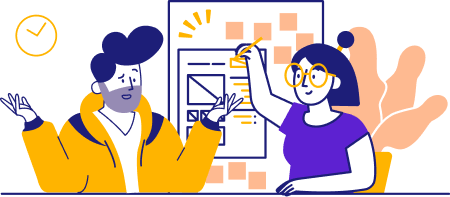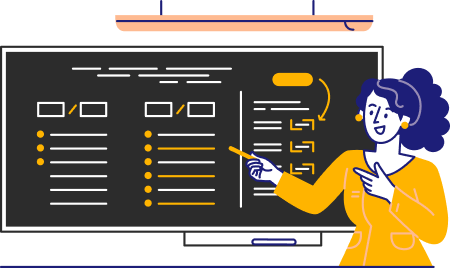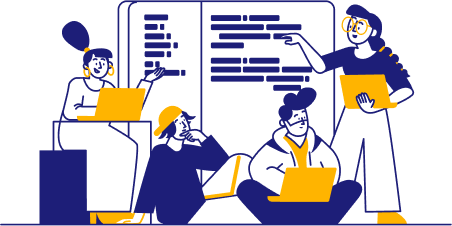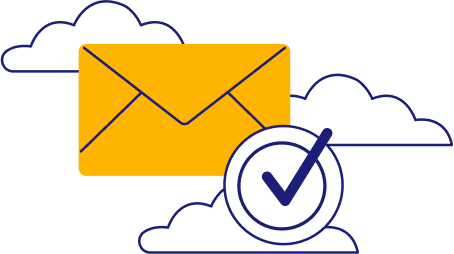Just like you’ve probably sent your fair share of cover letters and resumes in your time, HR managers and recruiters receive a daunting amount of job applications on a daily basis.
Want to know a great way to stand out and increase your chances? It’s simple: use a resume builder to make sure you tick all the boxes, and then, don’t forget to follow up on your job application!
Following up shows that you care about this particular role and are eager to get an interview. In this guide, we’ll tell you how to follow up on a job application so that you can ace that part of the job-hunting process!
Timing and Preparation for Following Up

Timing that follow-up email after your application is a meticulous kind of art. If you do it too soon, you’ll appear overeager or entitled; if you do it too late, the job may be long gone, and with it, your chances.
Don’t let this stress you out, though. It’s important to remember that doing this at all gives you an edge over other applicants in the first place. Let’s discuss the perfect time to follow up and increase your chances!

Timing is crucial
There are a few recipes for success when it comes to following up on your job application, but if we only had the time to give you one tip (which we don’t, so keep reading!), we’d tell you that timing is the key.
Remember that in certain industries, recruiters get so many resumes, many of them highly professional resumes, that they barely know what to do with them. Even if you’re an incredibly specialized pro looking for one of your dream jobs, you’re still going up against other, equally professional applicants. Such is life (and the job market).
So, when is the perfect time to follow up? The ideal time frame is about one to two weeks. At that point, it’s reasonable to expect that someone has reviewed your application, so there’s no harm in checking in.
There are a few things to consider when following that one-to-two-week rule, though.
- Check the job description. You might find a note on the timeline for reviewing applications and contacting candidates. If there is one, don’t follow up until that date has passed.
- Holiday periods. If you’re applying around the holidays, it’s a good idea to give the recruiter extra time to get back to you.
- Is it urgent? If the job indicates that the company is hiring with some urgency, follow up within a week at the most.
This approach will make sure that you’re coming off as respectful and interested!

Preparing your application review
Before following up, double-check your application to ensure it is complete and error-free. This step is crucial as it will prevent any embarrassment in case the hiring manager decides to revisit your materials.
Here’s a scenario that might keep you up at night: imagine sending a follow-up email to a job you’ve never even applied to. Terrifying, right?
While unlikely, it can happen. Some employers expect you to use their own platforms, others may want emails. It’s a lot to keep track of, so just like you may use a resume checker to ensure your resume is shipshape, do the same with your actual application before checking in.
Here’s our handy checklist:
- Check if you’ve really sent your application
- Verify that it’s been over a week
- Go over the job description and make sure that your initial application meets all the requirements
- Check your spam folder to ensure that you really haven’t gotten a response
- Go back to the company website and the job description and check whether the job is still open
- Make sure that the company isn’t against being contacted
Once you’ve ticked all those boxes, you’re good to go.

Finding the right contact
Just like it’s super important to address your initial job application email to the right person instead of using a generic “Dear Hiring Manager,” it’s just as crucial to address the correct contact in your follow-up email.
Ideally, you’ll want to contact the same person that you sent the initial application. For instance, if you addressed a specific hiring manager or recruiter, start your email the exact same way. However, if you used a general starter—which can happen—you can do some digging again.
Check the job listing, the company’s LinkedIn, and its website to try and find out the name of the person responsible for the hiring process. If every search still comes up fruitless, resort to an alternative such as “Dear Hiring Manager” or “Dear [Company] [Department] Team.”
We cannot stress this enough—a personalized opener gives you some major brownie points, so do your best!
Crafting the Perfect Follow-up Email

You’ve probably pored over your cover letter for hours (unless you used a cover letter generator), so you’re no stranger to crafting something that reads perfectly. Now, it’s time to apply that same perseverance and energy toward the mythical follow-up email.

Keep your message concise and clear
Don’t mistake the follow-up email for a second cover letter. This one is meant to be concise and to the point, focused on the fact that you’ve already applied and you’re eager to hear back because you really want this job.
Busy hiring managers will appreciate that you checked in if your resume slipped past them the first time, but if they’re greeted with a wall of text, they might be deterred from reading past the first line.
As a rule of thumb, you should use short paragraphs to increase readability. Your letter, as a whole, shouldn’t be long either. There’s not that much information that you need to convey here, so one or two short paragraphs plus the opener and the signoff are more than enough in most situations.
With limited space, what do you put in your job application email? We’ll go over it below.

Reiterate your interest in the position
You’re getting in touch with the sole purpose of reminding the reader that you’re still very much interested. As such, it’s good to get that information out of the door in your very first paragraph, and within the first one or two sentences.
Genuine interest in the position goes a long way. Express how excited you are about the possibility of working there and let your passion come through in your writing.
At the same time, it’s a good idea to acknowledge that the reader is likely busy, indicating that you don’t intend to take a lot of their time.
This will probably add up to two sentences, so make sure they’re both impactful and specific. No generic stuff like “I’m interested and hope you can contact me soon.” Dig deeper so that they know from the get-go that you don’t just send the same message to every job that you apply to.
Here’s an example:
“I hope this email finds you well. I completely understand that you are busy, however, I wanted to reiterate that I’m thrilled at the prospect of working with Nintendo as a senior engineer.”
Now, who could resist that?

Highlight your relevant skills
We’ve gone over your opener, and now, it’s time to move on to the second paragraph where you can highlight the skills that make you the right person for the job.
Remember that chances are, the recipient may have already familiarized themselves with your skills the first time you wrote. Similarly, now they can just jump back to the previous email and see the skills you chose to highlight there. You don’t want to repeat the exact same thing.
Read the job description closely and try to determine one or two key skills that make you the perfect candidate for the job. This can just be your experience in a given industry, too.
Following on from the example above, you could phrase it like this:
With over 10 years of experience in the gaming industry, especially with Unreal Engine and Unity, I cannot wait to help your team develop immersive, exciting experiences for some of the world’s most beloved franchises.
That’s all you really need to say, but you can add another sentence if there’s a specific point you really want to drive home in regard to your job skills. What matters is that this is highly personalized—no two follow-up emails can be the same if you want them to have an effect.

Show gratitude
As much as we all wish that was not the case, nobody is owed a reply to a job application. This is why (among many other reasons) being nice to the hiring manager can go a long way.
Expressing your gratitude is a surefire way to make them appreciate your email as opposed to treating it as yet another thing they have to take care of.
You can do this by adding a sentence or two before you move on to the closer. In addition, it’s a good idea to show your readiness to provide them with any additional information that they might want based on seeing your resume.
Here’s one way to tackle this part:
I would be happy to provide any additional information you might require at this stage of the application process. Thank you so much for your consideration.
We’re approaching the end of your follow-up email. It’s now time to move on to the sentence that should get you an interview.

Express your desire for an interview
If you’ve ever worked in sales, copywriting, marketing, or a similar field, you’ve probably heard of the call to action (CTA).
This is basically a short line that you include near the end of your email that should spur the reader into action. In this case, you want to get them to get back to you and invite you for an interview.
Adding a CTA at the end of your email, making it clear that you’d love to get a chance to be interviewed, is a good way to both cement the idea that you’re excited to work there and to actually get them to reach out to you.
This should be a single line, like this:
I look forward to hearing from you and discussing why I’m a good fit for this role during an interview.
If you feel the above is a little too confident or presumptuous, just shorten it to “I look forward to hearing from you.”

Proofread your email
The power of a single typo in an email sent to a recruiter is staggering. No matter the job, chances are that the company is looking for someone highly professional, and unfortunately, the smallest typo might discredit you in the eyes of the recipient.
It’s a good idea to use a free spell checker to start with. Next, go over your email at least twice: first starting from the beginning, and then reading from the end to the start. This will help you catch awkward wording, typos, and any instances of wordiness.
Lastly, if you can spare the time and there’s no pressing deadline for this email, you can sleep on it and go back to it the next day to catch any errors or fix anything you’re not too happy with.
Only send your email once you feel it’s concise, impactful, respectful, and full of interest in the job.
Different Methods to Follow up on a Job Application

We’ve covered how to follow up on a job application via email, but that’s not the only way to check in with your future employer. With that said, emails are often the most common, but it’s all up to the job—you may find that different employers prefer different ways of your getting in touch with them.
From emails to phone calls, here are different ways to follow up with a recruiter.

Email follow-up
We’ll be honest with you—the vast majority of hiring managers prefer that you send them an email. This is true for job applications and any follow-up contact.
Some of us have been taught that the best way to be noticed is to show up in person or call, and that might have been the case once upon a time. These days, most people prefer to just get an email that they can respond to whenever they have the time.
Sending an email is all kinds of right for most jobs. It’s respectful, it’s quick, it’s concise, it’s easy to spot. Most importantly, it’s never going to interrupt an important meeting or arrive at the worst possible time. The hiring manager can read your email, acknowledge it, and get back to you at a time that suits them best.
However, some companies may appreciate the more proactive approach of calling or sending a message on LinkedIn. Before settling on a method, do some research, read up on the job description, and if possible, try to follow up the same way you sent the resume in the first place.

Phone call follow-up
If you’re extra eager to make a memorable impression, and you’re feeling more than a little brave, you could always call the company to remind them that you’re waiting. However, there are a few important pointers to keep in mind before you pick up the phone.
- Check that they’re okay with taking calls. You won’t always know this for a fact, but browsing through the company’s website, LinkedIn, and the job description can be helpful.
- Don’t call on a Monday. If you can avoid it, it’s better to call in the second half of the week, as most people are slammed with work on Mondays.
- Don’t call in the morning. Similarly, mornings are often the worst, and not just due to a lack of sleep. Try to call after lunch hours to ensure that you’re not interrupting.
- Prepare a script. Unless you’re the most confident and chatty person on the planet, don’t go in without some prep beforehand. Prepare a rough script so that you know what to say and ask about.
- Learn the name of the hiring manager. If you’re calling the company, try to learn the name of the person in charge of hiring beforehand so that you can make a good impression.
Following up with a phone call is a high-risk, high-reward scenario. If you catch them at the wrong time, they won’t love it, but if you time it right, they’ll remember you.

LinkedIn message follow-up
Using LinkedIn is a good compromise that might give you a slight edge over emails, but without risking annoying them with a pesky phone call.
Depending on the job application process, the person in charge of recruiting might get a lot more emails than they do LinkedIn messages.
If that’s the case, your LinkedIn follow-up might hit just the right spot. It’ll be a permanent reminder that you messaged them, but they’ll still be able to get back to you whenever they have the time.
However, it’s highly situational, so here’s when you might want to use it:
- If you have a connection with the hiring manager or recruiter
- If you have any mutual connections with someone from the company
- When you have an established, active LinkedIn profile that you don’t mind them seeing
- If you’re sure that they are active on LinkedIn and will see your message
Some people have LinkedIn profiles that they hardly ever use. If that appears to be the case, you’re better off shooting them an email—after all, what matters is that they see it.

In-person follow-up
Of all the ways to follow up on a job application, showing up in person might be the most controversial. It’s certainly the most intrusive of all the options, but there’s no way they’re ever going to forget you if you visit.
Plus, seeing them in person, you might end up having an impromptu interview and being able to prove yourself much more than you ever could with an email.
In certain companies, in-person follow-ups are simply not a thing. Large corporations won’t let you enter beyond the front desk without an invitation or someone to escort you in. However, smaller companies where only a few people work at any given time are a safer bet.
If you do decide to go and visit the company to ask what’s up with your application, we recommend doing this if you also dropped off your resume in this way. In any case, keep your visit short and highly considerate of the hiring manager’s time.
Follow-up Examples and Templates

Crafting your own follow-up message can be a little daunting. It’s not like using a resume outline—it’s much more difficult to speed up and automate.
We’re here to save you some time. Check out our examples of real-world follow-up messages so you can make yours as great as it can be.

Standard email follow-up
This is a one-size-fits-all example email that should work for any job within any industry. Remember to modify it to make it your own.
Dear Ms. Bridge,
I hope you’re having a fantastic week. I don’t mean to take up too much of your time, but I just wanted to express my continued interest in the columnist position at Bustle. As a journalist with a degree in psychology and 5 years of experience covering relationships in magazines such as Glamour and Vanity Fair, I am ready to provide useful and actionable advice to your readers.
I’d be happy to provide any further information you might need. Thank you so much for considering my application.
I look forward to hearing from you and getting the opportunity to discuss why I’m a good fit during an interview.
Best regards,
Eloise Sharma

In-depth follow-up
When you want to highlight your skills more comprehensively, it’s perfectly fine to send a longer follow-up email. This version extends the previous one to two paragraphs, providing ample space to detail your skills and qualifications.
When tailoring it to match your application, make sure there’s no overlap between this one and your original application email.
Dear Mr. Watson,
I hope my message finds you well. I completely understand that you might be busy. However, having recently applied to work with you, I’m now reaching out to reiterate my immense interest in the position of customer service specialist at Asurion.
I believe that my background in the mobile space will help elevate Asurion’s customer-centric approach to new heights. I have worked with leading brands in the industry, such as T-Mobile and Nokia, and I’m an expert on both Android and iOS.
Please let me know if you need any additional information from me at this stage. Thank you so much for your consideration.
I look forward to hearing from you.
Sincerely,
Jenna Lisiecki

Phone follow-up
If you’re feeling up to it and want to be extra ready for when you make that phone call, we’ve prepared an example script for you that you can follow when you inquire about your application.
Aside from our script, remember to brush up on the contents of your resume and be ready to answer questions. If you connect with the hiring manager, they might want to learn more while they already have you on the line.
- “Hello, this is Olive Hutchinson. May I please speak with [the hiring manager’s name]?”
If you manage to get through to the hiring manager (or any other person in charge of hiring), proceed with the following:
- “Hi, Mr. Olafsson! My name is Olive Hutchinson. I hope that I’m not interrupting you. I’m calling to follow up on my recent application for the chemistry teacher position at Lincoln High. I wanted to once again express my enthusiasm for this position and ask whether there have been any new updates on the hiring process.”
- If given an update: “Thank you so much, Mr. Olafsson. I’m immensely excited to be in the running and I will eagerly await any future updates. Please let me know if you need any further information from me at any time. Have a fantastic day!”
- If there are no updates: “Thank you for letting me know. I completely understand and will be looking forward to any future updates. I would sincerely love to work with you at Lincoln High. Please feel free to reach out if you ever have any questions. Have a great day!”
If you can’t get a hold of the hiring manager, try this:
- “I understand. Would it be possible for you to take a message for me?”
- If they say yes, follow with: “My name is Olive Hutchinson and I’m following up on my application for the role of chemistry teacher at Lincoln High. I wanted to express my continued interest in the role and check whether there have been any updates in the hiring process. I can be reached at (123) 456 789 and via email at [email protected]. Thank you so much for your help!”
- If they say no, try this: “I understand. Do you know when they might be available for a quick chat?”
- Alternatively, end the call: “I understand. I will try again at a later time. Thank you so much!”

LinkedIn follow-up
LinkedIn messages have to be short. If you’re not connected, you’re limited to 300 characters if you’re sending a note with a connection request. InMail is longer, up to 2,000 characters, but you never want to use anywhere near that many words.
In addition, LinkedIn messages can sometimes be a little more on the casual side, but this depends on the person you’re reaching out to.
Below is a short example of a LinkedIn message.
Hi Neil, I hope this finds you well!
I’m reaching out to express my continued interest in working with you at HP in the role of a junior software engineer. I’m a recent computer science graduate with a passion for AI. Check out my portfolio for a glimpse of my skills in Python, C++, R, and JavaScript.
I would be happy to provide any additional information you might need. Thank you so much for your consideration.
Best regards,
Monica
Follow up on a Job Application FAQs

The perfect time to follow up on a job application is between one and two weeks. Check the job description to make sure there are no additional guidelines for this.
If you don’t get a reply after the first time you follow up, it’s alright to reach out one more time after waiting for another week. After that, it’s time to let it go and move on to other opportunities.
Emails are generally the standard way of following up on a job application. Phone calls can be seen as intrusive. However, if you have the hiring manager’s phone number, it can make you stand out from other candidates.
Your follow-up email should include a polite greeting and a reminder of the position you’re applying for. Next, reiterate your interest in the position and highlight a couple of your core skills that align with the job description. Express your readiness to supply any additional information and thank them for their consideration.
Try to find the email by going through the job description, LinkedIn, and the company website. If you still can’t find it, reach out to the same email you sent your application to in the first place or contact a general company email used for recruiting purposes.
If you don’t hear back despite reaching out, you can send a second follow-up email after another week or two. At that point, continue your job search. Give it a few months before you reapply to that same company.





